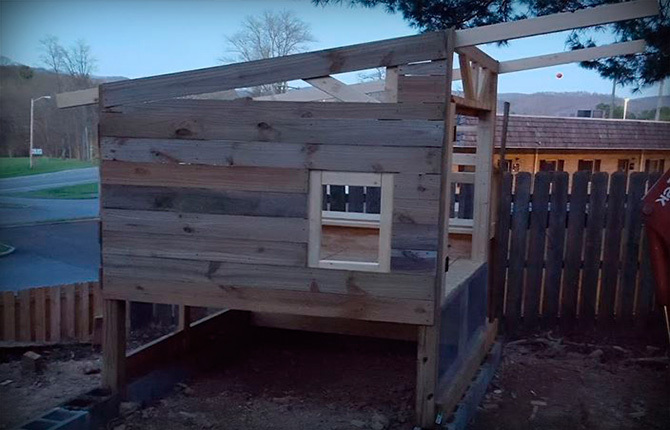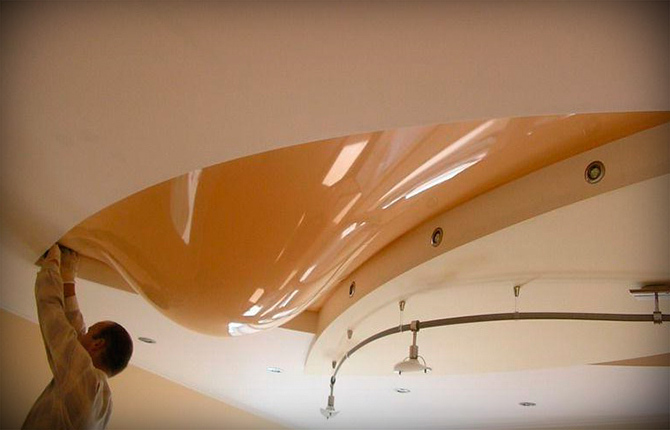One of the materials for arranging paths and playgrounds is paving slabs. It is used on an industrial scale and in domestic conditions. Before laying paving slabs on the sand, you should prepare the base, the necessary tools and materials.
The content of the article:
-
Types of tiles
- Vibropressed parts
- Vibrocast products
- Working tool and materials
-
Laying technology
- Preliminary work
- Soil development
- Installation of curbs
- Support-drainage backfill device
- Sand layer for laying tiles
- Tile laying
- Sealing of tile joints
- Some Helpful Tips
Types of tiles
You can lay tiles on the sand, the thickness of which is at least 40 mm. Thinner panels are mounted on a cement-sand mortar. So it is possible to create a single canvas that is resistant to mechanical damage. Paving slabs are divided into 2 groups of products.
Vibropressed parts
The technology involves pressing concrete mix. At the same time, the composition has a minimum amount of moisture.
Used in the manufacture specialized press. So it is possible to obtain products that are resistant to temperature extremes, the negative effects of moisture and mechanical damage.
The vibrocompression method is widespread on an industrial scale. This is due to the need to use specialized equipment.
Vibrocast products
The method involves the manufacture of parts from a cement-sand mortar. The production of tiles of this type is possible in domestic conditions. Work is carried out in the following sequence:
- Prepare forms. The inner surfaces of the formwork are moistened with lubricants. This makes it easier to remove the finished part.
- Pour in the solution. For the outer layer, a mixture with a fine filler is used. Dye is added to change the color. The inner layer is made from a solution with a large filler.
- Place the molds on a vibrating table. Under the action of vibration, air bubbles come out of the mixture. This increases the strength of concrete.
- Waiting for the mixture to solidify.
- Remove panels from forms.
On the footpath, you can lay paving slabs of any group. A person independently determines which type of panels to choose.

Working tool and materials
You can lay paving slabs on the sand yourself. This does not require specialized education. The work will be done by a person with minimal technical skills. To lay paving slabs, you need the following tools and materials:
- Rammer. To speed up the process, specialized machines with an internal combustion engine are used.
- Rubber or wooden mallet. Metal tools can damage the panels.
- Angle grinder. Use a concrete disc. The diameter of the circle is selected separately for each case.
- Level. Necessary for leveling the site in a horizontal plane.
- Shovel. Use bayonet and shovel tools.
- Putty knife.
- Rule. You can use a long, even object - a wooden block or a piece of a profile pipe.
- Lighthouses and twine.
- Agrofibre or geotextile. Protect the site from grass germination.

- Crushed stone of different fractions.
- Coarse and fine sand.
- Cement.
- Paving slabs and additional elements (gutters, borders).
The list of tools is different for each case. A person independently determines the need to use a particular tool.
Laying technology
At the initial stage, a detailed plan will be required. To determine how to properly lay paving slabs on sand, the plan is supplemented with a drawing. It indicates the boundaries of the tracks and sites. When carrying out the calculation, the location of the trees is taken into account. Their roots will interfere with the arrangement of the pit.
The plan describes the sequence of actions. When working, adhere to a pre-prepared plan. So it is possible to lay paving slabs in a technological order.
Preliminary work
At this stage, the prepared drawing is transferred to the area. Beacons and twine are used for marking. Suitable rods, pieces of wooden slats, pieces of a profile pipe, etc. To make it easier to drive the beacons into the soil, their edges are sharpened.
Pegs are installed around the perimeter of the place where the tiles are laid.
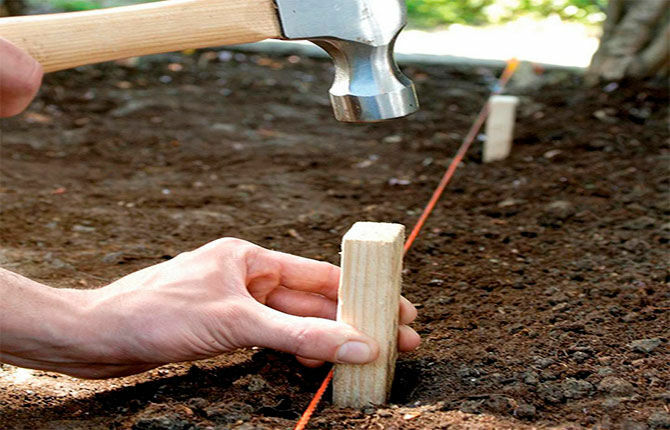
The distance between the beacons depends on the configuration of the finished canvas and is selected separately. When designating straight lines, the distance is 2-3 m. To make the surfaces of complex geometric shapes, the distance between the beacons is reduced.
The twine is pulled at a distance of 10-15 cm above the soil. A low-lying cord touches the soil at its elevation. This interferes with the normal layout of the markup.
After installing the beacons, they clean the work area from debris, shrubs, etc. At this stage, materials and tools are prepared. Paving slabs are laid around the perimeter in small batches. So during the work there will be no need to waste time on transportation. After the preparatory work, a laying pit is equipped.
Soil development
The technology provides for the preparation of the pit. It is necessary to accommodate a pillow of sand and gravel. To determine whether it is possible to lay paving slabs on sand when creating an automobile platform, the pressure on the ground is taken into account.
For cars, you can lay paving slabs on a cushion with a thickness of at least 250 mm. For heavy vehicles, the bulk material layer is between 300 and 500 mm.
To make a footpath, equip a pit with a depth of 200 mm. When digging, pay attention to the verticality of the walls. Their displacement in the lower part to the center of the trench will lead to difficulties in mounting the curb. At the stage of digging a trench, the occurring roots of trees and shrubs are removed.
To prevent the plant from growing through the seams of paving slabs, agrofibre is laid on the bottom of the pit. Additionally, the soil is treated with chemicals that block the growth of vegetation. The way these substances are used is different. The instructions supplied by the manufacturer must be followed.
Before mounting the canvas, clean the surface of sharp objects. These are stones, plant roots, etc. Its damage leads to the spread of vegetation.
Installation of curbs
Additional elements that delimit the path and the rest of the surface are mounted on a cement-sand mortar. Work is carried out in the following sequence:
- Knead the cement-sand mortar with a ratio of 1:3. To ensure the stability of the elements after installation, the solution is made thick.
- Install the curb dry. Check the correctness of its location in the vertical and horizontal plane. To do this, use the building level.
- Dismantle the accessory element.
- A solution is laid along the plane of contact of the part with the soil.
- Install products in place.
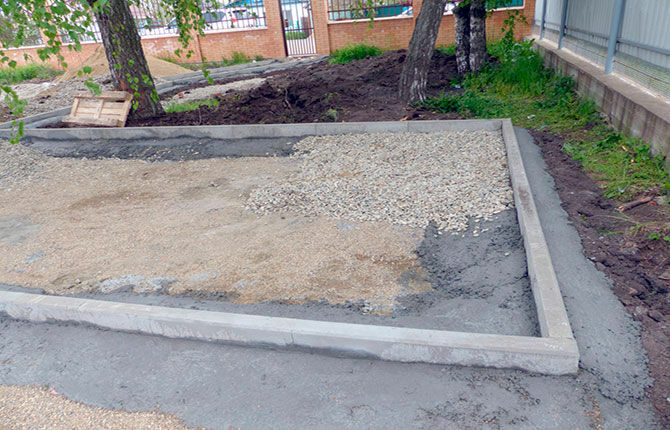
- Check the correct location. If necessary, correct the position of the part with a rubber or wooden mallet.
- Equip metal or wooden spacers. They are necessary for fixed fixation of the product until the concrete mixture has completely solidified.
- Wait for the solution to dry.
Putting the solution is necessary after fitting the curb in place. Spreading the mixture around the entire perimeter will lead to difficulties when changing the position of the part in the vertical and horizontal plane.
Support-drainage backfill device
Before laying paving slabs on the sand, equip the drainage layer. It is necessary to remove moisture. For this, crushed stone of a fine fraction is used.
To exclude the possibility of damage to the agrofibre, about 30 mm of sand is poured into the bottom of the pit. Before backfilling, the material is sifted to remove stones. The lower sandy layer is leveled and compacted.
The next stage is the manufacture of the support-drainage layer. At the bottom of the pit, crushed stone of a fine fraction is poured. Cushion thickness 100 mm. If you need to lay paving slabs on the car platform, increase the thickness of the pillow. The drainage layer is made as follows:
- pour rubble;
- level the material with a rule or an even beam;
- compact the surface with a manual or mechanized rammer;
- fill the pillow with coarse sand;
- water the resulting coating with water;
- re-tamping is carried out.
Wait for the surface to dry before the next step. Moisture comes out of the material in 1-2 days. After drying, proceed to the arrangement of the substrate under the paving slabs.
Sand layer for laying tiles
Before laying paving slabs, a sand cushion is made. There are no standards that determine which sand paving slabs are laid on. It is important to choose a material that has a minimum number of stones. Before laying the slabs, sift the sand.
A layer of cleaned sand 50 mm thick is poured over the drainage cushion. After that, the surface is leveled with an even beam. The correctness of the location in the horizontal plane is determined by measuring the distance from the edges of the curb.
The substrate is made in 2 stages. The first step is to pour a layer 20-25 mm thick. Wet the surface with water and tamp.
After compaction, the remaining material is poured out, leveled in a horizontal plane and compacted. So it is possible to obtain a sand substrate that is resistant to mechanical stress.
Tile laying
Laying tiles on the sand is necessary in the direction away from you. So a person will not violate the integrity of the sand substrate. Putting parts on the sand should be in a certain sequence:
- Install the element in accordance with the drawing indicated in the drawing. The first part is installed near the curb. A gap of 2-3 mm is left between the tile and the dobor.
- Check the correct position in the horizontal plane. Use the building level. If necessary, the product is dismantled and sand is removed or added.
- Plant the tiles on the sand with blows of a rubber or wooden mallet. Its size is calculated separately for each case. For large slabs, you will need a hammer weighing 700-800 g. To lay thin slabs, light hammers are used.
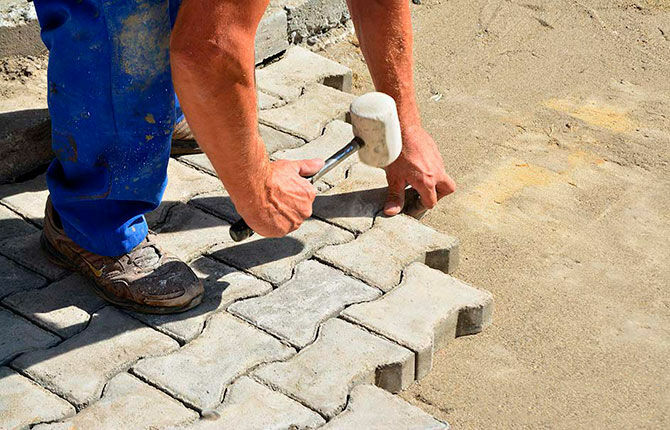
It is necessary to lay the following plates in the same sequence. In this case, there should be the same gap between the side surfaces, so plastic crosses, wooden pegs, etc. are used.
During the laying process, it will be necessary to trim the slabs at the junction with curbs or vertical surfaces. The part is cut with an angle grinder with a cutting wheel for concrete.
Sealing of tile joints
To prevent the ingress of contaminants between the side surfaces of the plates, after installation, the seams are overwritten. To fill them, dry sifted sand or a cement-sand mixture is used. In the first case, water will seep through the seams, in the second it will be possible to seal the coating. The procedure is carried out in the following sequence:
- Bulk material is prepared. The sand is sifted to prevent the ingress of stones. In the manufacture of a cement-sand mixture, a ratio of 1: 3 is taken.
- Pour sand or mixture in small portions over the entire surface area.
- Rub the seams with a spatula.
- The remaining sand is removed with a broom.
- Fill the seams with water. In this way, the composition can be compacted.
- After subsidence of the mixture or sand, the procedure is repeated.
After completion of work, the remaining sand is swept from the surface. It may be necessary to repeat the grouting procedure after precipitation.
You can also read about the general principles of laying tiles in various ways. link.
Some Helpful Tips
You can lay paving slabs on the sand yourself. It is important to follow the sequence of actions. To facilitate the procedure, several rules are taken into account:
- With a small depth of groundwater, a drainage channel is additionally equipped. At the same time, it is necessary to lay paving slabs under a slope.
- The material is purchased with a small margin. So it is possible, if necessary, to replace failed parts.
- Choose paving slabs with restrictive ledges on the side surfaces. In this case, the gap between the plates will be the same. This does not require the use of crosses.
Laying paving slabs on sand can be done by a person who does not have skills in the construction industry. At the initial stage, it is important to draw up an exact action plan and stick to it in the process.
Have you laid paving slabs on the sand yourself? What type of tamper was used to make the pillow? Leave comments and share the article with your friends on social networks. Bookmark it so you can come back to the tiling instructions later.
We recommend watching a selected video on the topic below.
Laying paving slabs on sand:
Laying paving slabs on sand and the result in a year:
Plastic paving slabs - advantages and disadvantages, how it is made and how it fits? About it Here.
